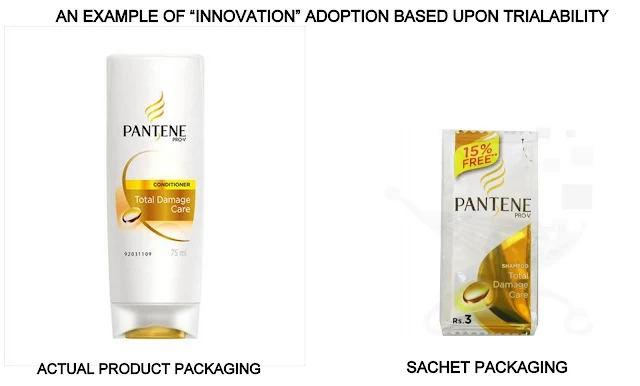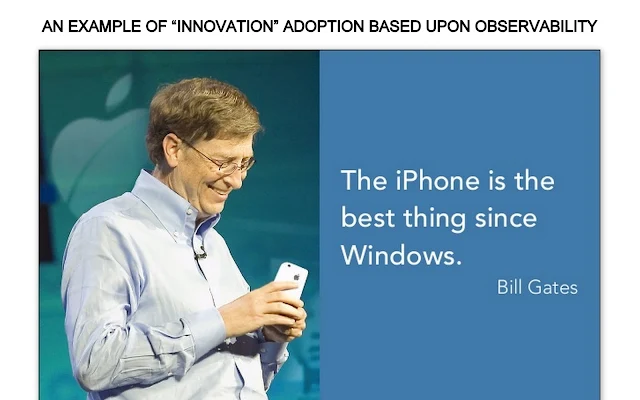In simplest words, "Adoption" is the acceptance of a new idea and product by the consumer. Every new product is launched for being adopted. But all new products do not necessarily become huge successes.
In simplest words, "Adoption" is the acceptance of a new idea and product by the consumer. Every new product is launched for being adopted. But all new products do not necessarily become huge successes. The product innovation needs to possess certain basic attributes for it to spread quickly to the target market. These attributes influence the rate and the time, generally taken by the "innovation" to be adopted by the consumers. The important attributes are:
i) Relative Advantage
ii) Compatibility
iii) Complexity
iv) Triablity
v) Serviceability
vi) Networkability
Now, let's elaborate above five factors with examples;
Relative Advantage:
Consumers come across large numbers of innovations, but only some are readily adopted by consumers due to the additional perceived benefits the innovation offers as compared to existing alternatives. This perceived benefits is referred to as relative advantage.
In a very general sense, relative advantage has a positive relationship with the diffusion of innovation, i.e., the higher the relative advantage, the larger number of consumers are inclined to buy it.
Compatibility:
Consumers have set behavioral patterns due to past experiences, beliefs, and habits. It is very difficult to change these patterns and marketers try to make their innovations compatible with the established usage and behavioral pattern of the consumers for quick adoption. Compatibility, thus, is the measure of consumer's perception of the innovation's consistency with their established usage and behavioral pattern.
Compatibility has a positive relationship with the diffusion of innovation,i.e., the higher the compatibility of the innovation with consumers' needs, values, and experiences, the larger the number of consumers will eventually adopt it.
Complexity:
Generally, consumers have tendency to adopt things which they understand and can use easily. Often, highly complex electronic gadgets leave people confused. The perceived complexity of an innovation is the degree to which the end consumers find an innovation difficult to understand and use. Complexity has a negative relationship with the diffusion of innovation, i.e., if consumers find a new product very complex in nature, very few will be interested in actually purchasing it.
In the case of technological innovations liked application-based software and hi-tech gadgets, the issue of the consumers' ability to adopt the innovation gains more importance than their willingness to adopt it. The consumers' comfort level with the technology goes down considerably if they need to understand lot of operational technicalities in order to use the innovation.
Trialability:
Trial of a new product before purchase often helps consumers to make the purchase decision. Perceived trialability of an innovation is the extent to which the consumers can experiment with it. This has a positive relationship with the diffusion of innovation. It is very important in high-value products like designer clothing, and products directly affecting the general health and well-being of consumers, like personal care and food items. Since trialability reduces the perceived risk of adoption, it facilitates the buying decision of consumers. In emerging markets, small sachets have provided consumers with the opportunity to try a product before finally adopting it. Examples of trialability also includes test-driving in case of automobiles, trial of ready-made garments to check fit and look, and the demo version of games and application software launched for a small duration of time.
But trialability does not affect services like air travel. There is no possibility of a trial on an experimental basis, for such services. That's why, in products where opportunity to actually try a product is very limited or does not exist, the role of opinion leader and word-of-mouth communication is considered to be extremely important.
Observability:
New products which are visible to other potential adopters diffuse at a faster rate. Perceived observability or communicability is the ease with which innovation's feature and benefits can be observed by other prospective buyers.
Observablity has a positive relationship with the diffusion of innovation. Clothes and accessories, automobiles, etc., are examples of products with high observability, but in case of products like a new model of industrial cooker or exhaust fan, the benefits are not on display in public and so are not very obvious.
Networkability:
With the rise of the internet, certain externalities or external factors are directly influencing the new product innovations, where it can be used as a part of a network. It describes the direct relationship between a networked innovation's use-value to a new adopter, and the total size of the network. The bigger the total user network, the more the use-value to the new adopter.
Innovations with network externalities have four unique characteristics which have an impact on the adoption. They are as follows;
1. Greater expense for the consumer
2. The time to generate returns on the innovation is shorter due to stifled competition
3. The company has the incentive to indulge in the penetrative pricing to accelerate the diffusion.
4. High returns if the product is successful with technological lock-ins (use of compatible technologies to operate a product)
One important point to note in case of the networked innovations is the pricing. If prices are fixed too low, this can lead to the network overload (number of users using the network is more than the network's capacity) while too high a price can make the product too expensive for the consumer. Clearly, the factors that affect adoption of the networked innovations need to be looked at carefully in order to predict adoption with accuracy - a major challenge for innovators.
Conclusion:
Besides above mentioned six basic factors, time will always remain a "crucial" factor which connects the adoption process, the consumers' innovativeness, and the rate of adoption. Other factors affecting adoption are the type of social system (modern or traditional), type of decision (individual or group), marketing effort (correct market segmentation and communication channels), need fulfillment/ problem solving (the more obvious the problem solved by the innovation, more rapid the adoption), and perceived risk (the lower the perceived risk, the higher the probability of faster adoption). Based on these, consumers have been classified as innovators, early adopters, early majority, later majority and laggards under the "theory of diffusion of innovation".
Innovations with network externalities have four unique characteristics which have an impact on the adoption. They are as follows;
1. Greater expense for the consumer
2. The time to generate returns on the innovation is shorter due to stifled competition
3. The company has the incentive to indulge in the penetrative pricing to accelerate the diffusion.
4. High returns if the product is successful with technological lock-ins (use of compatible technologies to operate a product)
One important point to note in case of the networked innovations is the pricing. If prices are fixed too low, this can lead to the network overload (number of users using the network is more than the network's capacity) while too high a price can make the product too expensive for the consumer. Clearly, the factors that affect adoption of the networked innovations need to be looked at carefully in order to predict adoption with accuracy - a major challenge for innovators.
Conclusion:
Besides above mentioned six basic factors, time will always remain a "crucial" factor which connects the adoption process, the consumers' innovativeness, and the rate of adoption. Other factors affecting adoption are the type of social system (modern or traditional), type of decision (individual or group), marketing effort (correct market segmentation and communication channels), need fulfillment/ problem solving (the more obvious the problem solved by the innovation, more rapid the adoption), and perceived risk (the lower the perceived risk, the higher the probability of faster adoption). Based on these, consumers have been classified as innovators, early adopters, early majority, later majority and laggards under the "theory of diffusion of innovation".
About the Author:
Rahul Guhathakurta is the founder of IndraStra Global. He tweets at @rahulogy
[1] Rogers EM: Diffusion of Innovations. 1995, New York: Free Press, 4
[2] Song M, Read S. "DINAM : A Model of Innovative Product Adoption in the presence of Direct and Indirect Network Externalities"
[3] Fichman, R.G "Information Technology Diffusion : A Review of Empircal Research" MIT Sloan School of Management, https://www2.bc.edu/~fichman/Fichman_1992_ICIS_IT_Diff_Review.pdf
[4] Katz, M.L , Shapiro, C "Technology Adoption in the presence of Network Externalities", Journal of Political Economy, 1986, Vol. 94, No.4

























